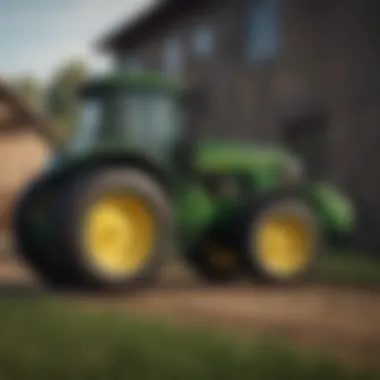In-Depth Analysis of John Deere Tractor Prices in India


Intro
The agricultural sector in India is becoming more sophisticated, and tractors play a crucial role in this transformation. Specifically, John Deere tractors have established themselves as a prominent choice among farmers and agricultural enthusiasts. Given the importance of tractors in improving productivity and efficiency, understanding the pricing of John Deere tractors is essential for potential buyers. This analysis aims to provide insights into the various factors affecting these prices, model comparisons, and the broader implications for the agricultural industry.
Key Concepts and Terminology
Basic Definitions
When engaging with John Deere tractors, it is necessary to familiarize oneself with foundational terms. Key concepts include:
- Tractor: A powerful motor vehicle designed primarily for the purpose of hauling agricultural implements.
- Model Variants: Different configurations and specifications of tractors that cater to diverse agricultural practices and needs.
- Horsepower (HP): A unit measuring the power output of the tractor's engine, influencing its capacity and performance.
Historical Context
John Deere has a long-standing history in India, dating back several decades. The company began its operations in the 1990s, focusing on providing robust agricultural machinery. Over the years, John Deere has adapted to local farming practices, enhancing its relevance in a rapidly evolving market. This historical perspective helps buyers understand the reputation and legacy associated with John Deere tractors, impacting their pricing strategies.
Recent Innovations and Trends
Technological Advancements
The tractor market is not stagnant; it evolves consistently. John Deere, for instance, is at the forefront of incorporating technology to improve tractor performance. Innovations like GPS integration and smart farming technologies are now common in many models. These advancements can lead to increased pricing, reflecting the additional features and improved operational efficiencies.
Sustainable Practices
Sustainability is increasingly influencing land cultivation and tractor usage. John Deere has introduced models designed to be more fuel-efficient and environmentally friendly. Such initiatives not only contribute positively to the environment but also carry a financial implication. Tractors built with sustainable practices often carry a higher price tag due to research and development costs, appealing to environmentally-conscious consumers.
Practical Applications and Techniques
Step-by-step Guides
When considering a purchase, it is essential for buyers to approach the decision with a clear strategy. Here is a basic guide:
- Assess Your Needs: Determine the scale of your agricultural operations.
- Research Models: Look into various John Deere models, their specifications, and pricing.
- Evaluate Costs: Consider both initial purchase price and long-term operating costs.
- Sample Reviews: Read existing customer feedback and appraisal for additional insights.
Case Studies
Examining real-world cases can provide additional clarity. For example, a case study from a farmer in Haryana who invested in a John Deere 5105 model reveals how the initial investment was recouped through increased crop yield and efficiency. This practice-oriented approach showcases not only the financial aspects but also the operational benefits of choosing the right model.
"Investing in tractors is not merely about the purchase price, but also the long-term value it brings to the agricultural operation."
Prologue to John Deere Tractors
Understanding John Deere tractors is crucial for those involved in agriculture and farming in India. John Deere has long been recognized as a leader in agricultural machinery, offering a diverse range of products tailored to meet the varying needs of farmers. In this section, we will delve into the historical context and the company's current market presence in India, uncovering the significance of John Deere in the agricultural landscape.
Historical Background
John Deere was founded in 1837 by a blacksmith who believed in providing farmers with high-quality tools. This commitment to quality has shaped the brand's reputation over more than a century. Initially focused on producing plows, the company expanded into other agricultural equipment as technological advancements progressed. John Deere’s early innovations made farming more efficient, ultimately transforming agricultural practices.
The introduction of tractors in the early 20th century marked a significant turning point. John Deere quickly recognized the potential of tractors to increase productivity on farms. Today, their history includes numerous advancements from the first gas-powered tractor to today’s modern equipment equipped with GPS technology, highlighting the brand's adaptability and focus on innovation. This historical foundation creates a powerful narrative around the brand, appealing to farmers who prioritize reliability in their tools.
Current Market Presence in India
In India, John Deere has established a strong market presence, becoming a preferred choice for many farmers. The company's investment in manufacturing facilities in India not only shows their commitment to the market but also makes their tractors more accessible to Indian consumers. John Deere offers a range of tractors that cater to different farming needs, from smallholder farmers to large-scale operations.
The company provides models with varying horsepower and features, which allows farmers to select the best fit for their specific agricultural practices. Moreover, John Deere’s focus on after-sales service and support has reinforced its reputation in the region. This service-centric approach ensures that customers have reliable assistance, fostering lasting relationships with the brand.
In summary, the historical evolution and strong market presence of John Deere in India underscore its importance in the farming sector. Understanding these elements helps potential buyers appreciate the value and reliability of investing in John Deere tractors.
Factors Influencing John Deere Tractor Prices
Understanding the different elements that affect the pricing of John Deere tractors is crucial for any prospective buyer. These factors encompass a wide range of economic and market dynamics that ultimately determine the cost of ownership for these machines. An informed buyer will be better equipped to make decisions, which may lead to enhanced financial planning and operational efficiency in agricultural practices.
Economic Conditions
Economic conditions play a significant role in shaping the prices of tractors. When the economy is booming, farmers tend to invest more in machinery, which can drive up demand and consequently prices. Conversely, during economic downturns, there might be a reduction in spending power, causing a dip in demand for tractors.
The inflation rate also impacts the prices of parts and manufacturing. Higher inflation often leads to priced increases from manufacturers that are passed on to consumers. Furthermore, fluctuations in currency exchange rates affect import costs. Any adjustment in these rates can significantly affect the pricing of John Deere tractors, especially those that involve imported components.
Technological Advances


Technological improvements are another critical factor influencing tractor prices. John Deere is known for incorporating advanced technologies into their products. Features like GPS-guided systems, advanced sensors, and enhanced fuel efficiency create added value. However, the investment in research and development means that the initial pricing of new models might reflect these advancements.
Farmers must weigh the long-term benefits of higher prices against the potential increase in efficiency and productivity that these technologies can provide. For some, the higher upfront cost may be justifiable if it leads to significant operational savings.
Import Tariffs and Taxes
Import tariffs and taxes are significant considerations in determining the final price of John Deere tractors in India. When government policies impose tariffs on imported goods, it affects the manufacture's cost structure. This, in turn, can increase the price that consumers will ultimately pay. The level of taxation related to agricultural machinery can also have a profound impact on pricing.
Policies can vary widely, and any shifts in these regulations can dramatically alter the affordability of tractors. Buyers must stay informed about these elements to fully understand the financial landscape.
Market Demand and Supply
The principles of demand and supply are fundamental to understanding how prices are set. High demand for tractors during peak farming seasons can lead to price increases, while excess supply might cause prices to decrease. Seasonal trends significantly influence purchasing decisions; thus understanding peak times for demand can assist buyers in timing their purchases for optimal cost savings.
Also, the competitive landscape among manufacturers can impact pricing. When numerous brands vie for market share, competitive pricing strategies may emerge, offering consumers more choices at diversified price points.
By comprehending the factors that influence John Deere tractor prices in India, potential buyers can navigate the complexities of pricing effectively. This knowledge will aid in making informed decisions that align with their agricultural needs and budget.
Overview of John Deere Tractor Models Available in India
The study of John Deere tractor models available in India is crucial for several reasons. This section aims to inform the reader of the variety and capabilities of John Deere tractors, equipping potential buyers with the knowledge necessary for informed decision-making. Understanding the distinction between the different tractor models can also help in aligning the specific needs of agricultural tasks with the right equipment.
John Deere’s portfolio showcases a range of tractors, each designed with particular functionalities, sizes, and capabilities. This variation not only highlights the company’s commitment to meeting the diverse needs of Indian farmers but also enriches the competitive landscape within agricultural machinery. Knowledge of these models gives insight into their suitability for various types of agricultural practices.
Compact Tractors
Compact tractors from John Deere are particularly designed for small to medium-sized farms. Their smaller size and maneuverability make them ideal for tight spaces and specialized tasks such as landscaping, gardening, or light agricultural activities. They are easy to operate, making them suitable for both seasoned farmers and new users.
Features often include:
- Efficient Engine: Compact tractos typically offer a powerful engine while maintaining fuel efficiency.
- Versatile Attachments: Many models can be fitted with a variety of attachments such as plows, loaders, or mowers for enhanced utility.
- User-Friendly Controls: Designed for ease of use, these tractors offer intuitive control systems that can help minimize the learning curve.
The prices for compact tractors start at a more affordable range, appealing to those who may be hesitant to invest heavily at the outset.
Utility Tractors
Utility tractors are a staple in the farming sector, designed for a wide range of tasks. They serve as an adaptable solution for farmers who need versatility in their equipment. John Deere's utility tractors combine power with functionality, making them suitable for both agricultural tasks and property management.
Key characteristics include:
- Powerful Performance: These tractors are equipped with robust engines that can handle heavy loads.
- Multiple Uses: From plowing to mowing, utility tractors are capable of performing a variety of tasks.
- Comfort Features: Many models prioritize the user’s comfort with features like ergonomic seating and climate control.
The investment in utility tractors can be justified by their productivity and multi-tasking capabilities, making them popular among diverse farming operations.
Specialty Tractors
Specialty tractors from John Deere are tailored for specific tasks that require unique capabilities. These tractors are often sought after for their specialized features that can handle particular agricultural needs like vineyard or orchard management.
Attributes generally include:
- Tailored Design: The design of specialty tractors allows for operations in niche markets that standard tractors cannot adequately address.
- Enhanced Precision: Many models incorporate advanced technology for precision farming, aiding in efficiency and better crop management.
- Durability in Tough Conditions: These tractors are often built to withstand challenging agricultural environments.
Specialty tractors may command a higher price point but their precision and reliability can offset the initial investment for serious agricultural pursuits.
Price Range of John Deere Tractors in India
Understanding the price range of John Deere tractors in India is crucial for any farmer or enthusiast considering making an investment in agricultural machinery. The prices vary significantly based on the model, features, and the specific needs of the buyer. Knowledge of this pricing structure allows potential customers to make informed decisions, weighing the benefits against their fiscal capacities.
Several factors play a role in determining the cost of John Deere tractors, including production expenses, technological advancements, and market trends. Furthermore, understanding these price segments helps buyers to plan their investments more strategically, ensuring that they select models that align with both their agricultural requirements and budget.
Low-End Models
Low-end John Deere models are designed for small to medium-sized farms. These tractors generally come at a lower price point, making them accessible for farmers just starting or for those with limited budgets.
Typically, low-end models feature basic functionality and engine capabilities. An example includes the John Deere 3028D, which offers simplicity and effectiveness for routine fieldwork without imposing a high financial burden.
- Benefits of low-end models include:
- Cost-effective investment
- User-friendly controls
- Lower maintenance costs


However, buyers should consider the limitations in terms of power and capabilities as some may not be sufficient for larger farming tasks.
Mid-Range Models
Mid-range John Deere tractors offer a balance between affordability and advanced features. These models are aimed at larger operations or those requiring more features without going into the high-end price territory. Models such as the John Deere 5050D are known for their versatility and reliability.
Investing in mid-range tractors allows farmers to enjoy:
- Enhanced features
- Better fuel efficiency
- Improved power output
They are powerful enough to handle a variety of tasks, including plowing and heavy lifting, which makes them suitable for diverse agricultural applications. Mid-range models strike a good balance and can be a sensible choice for serious farmers.
High-End Models
High-end John Deere tractors are designed for large-scale agricultural operations that require sophisticated machinery. These tractors come equipped with the latest technology and advanced features that enhance productivity and efficiency. Models such as the John Deere 6105M exemplify premium performance and are suited for complex tasks and large fields.
Investors looking at high-end models can anticipate:
- State-of-the-art technological innovations
- Advanced hydraulic systems
- Exceptional power capabilities
The benefits of these tractors often merit the higher price tag, particularly for commercial operations where downtime can lead to significant losses. However, it's essential for buyers to evaluate cost-effectiveness, depending on their individual needs and operational scale.
The right choice of tractor can significantly enhance productivity and reduce operational costs over time.
By understanding the price ranges of John Deere tractors in India, potential buyers are better equipped to make informed decisions that align with their agricultural plans.
Financing and Ownership Options
Understanding financing and ownership options is crucial when considering the investment in John Deere tractors. This section explores different mechanisms available to potential buyers, offering clarity on how to approach the financial aspects of acquiring such machinery. Many farmers face the challenge of balancing operational needs with budgetary constraints. Therefore, having an awareness of the financing avenues can significantly ease this burden.
Loan Facilities
Loan facilities available for John Deere tractors provide farmers with a practical way to purchase equipment without the immediate financial strain. Many banks and financial institutions offer agricultural loans that cater specifically to the needs of farmers looking to buy machinery. Features of these loans often include:
- Low-Interest Rates: Financial institutions may offer competitive rates, making it easier for farmers to manage repayments.
- Flexible Repayment Terms: Loan terms can often be adjusted to fit the cash flow of a farming operation.
- Tax Benefits: In some cases, interest on agricultural loans can be tax deductible, reducing the overall cost of the loan.
"Understanding the trajectory of interest rates and loan terms is essential for farmers as they evaluate their purchasing decisions."
Farmers should diligently assess their financial situation before applying for a loan. Preparing documentation showing proof of income, operational costs, and anticipated profits will help in receiving favorable terms. Additionally, farmers may consider engaging with a financial advisor to navigate these options effectively.
Leasing Options
Leasing presents another viable alternative for farmers who may not want to pursue ownership outright. Leasing allows farmers to use John Deere tractors for a specified time period, making it a flexible option. Key aspects include:
- Lower Upfront Costs: Leasing usually requires significantly lower initial payments compared to buying, reducing immediate financial pressure.
- Access to New Technology: Leasing often allows farmers to upgrade to newer models more frequently, keeping them competitive.
- Maintenance Included: Many leasing agreements come with maintenance services, minimizing unexpected repair costs.
It is important for farmers to read the terms of any leasing agreement carefully. This ensures clarity on usage limits and any potential penalties. Moreover, evaluating the total cost of leasing compared to ownership helps in making informed decisions, tailored to specific operational needs.
Overall, understanding these financing methods equips farmers with tools to enhance their productivity while managing costs effectively.
Comparative Analysis with Competitors
Comparative analysis is vital when assessing John Deere tractors in the Indian market. Understanding how John Deere stacks up against its competitors can provide valuable insights for potential buyers. Customers often consider factors like price, performance, and features before making a decision. This section examines how John Deere compares to other major brands and what this means for consumers.
Comparison with Other Major Brands
John Deere competes with several prominent brands in India, including Mahindra, TAFE, and New Holland. Each of these manufacturers offers a variety of tractor models that appeal to different segments of the market.
- Mahindra: Known for its robust performance and affordability, Mahindra tractors tend to be popular among small to medium-sized farmers. Their models often offer good fuel efficiency and low maintenance costs, which attract budget-conscious buyers.
- TAFE: This brand emphasizes durability and service efficiency. You can find TAFE tractors well-suited for tough agricultural conditions.
- New Holland: This brand appeals with advanced technology and comfort features, targeting larger farming operations that prioritize efficiency and ease of use.
Every brand has its strengths and unique selling points. For instance, John Deere integrates advanced technology into its tractors, offering features like GPS tracking and precision farming tools. This technology enhances productivity but may come at a higher initial cost compared to some competitors.
Value for Money Considerations
Value for money is a critical aspect when selecting a tractor. It involves assessing not just the purchase price but also the long-term benefits associated with owning a specific brand.
- Initial Cost vs. Features: Buyers should weigh the initial purchase price against the features provided. John Deere tractors often come equipped with advanced technology, which could justify a higher price tag.
- Resale Value: John Deere tractors tend to retain a higher resale value due to their reputation for quality and durability. This is an essential factor for many farmers looking at their total investment over time.
- Maintenance and Service Support: An important aspect of value is post-purchase support. John Deere provides a robust service network, ensuring that maintenance and repairs are less of a hassle compared to some less prominent brands.
In summary, the comparative analysis with competitors reveals that while John Deere may come at a premium price, its technological advantages, strong resale value, and comprehensive support services can offer significant long-term benefits for agricultural operations in India.


Impact of Prices on Agricultural Practices
The analysis of tractor prices, particularly John Deere tractors in India, holds significant relevance for the agricultural sector. High prices can often deter farmers from making necessary investments in modern machinery, influencing their farming practices and overall productivity. Understanding price variations allows farmers to make informed decisions about their investments, impacting their approach toward agriculture.
Investment Strategies for Farmers
Farmers must consider various investment strategies in relation to the costs associated with purchasing John Deere tractors. The first step involves evaluating their financial capabilities. Understanding the total cost of ownership, including maintenance and operational costs along with the initial purchase price, plays a crucial role. Farmers can explore financing options, such as loans or government subsidies, to mitigate the impact of high upfront costs. Additionally, pooling resources with other farmers can enable shared ownership, making it possible to access premium equipment without a substantial single investment.
Here are some key investment strategies:
- Assess Financial Health: Farmers should calculate their return on investment (ROI) by analyzing current yields and the potential increase that new machinery could provide.
- Explore Government Schemes: Governments often provide incentives or subsidies for agricultural machinery. Understanding local policies can provide significant savings.
- Collaborative Purchasing: Joint investments in machinery with neighboring farmers can decrease individual burdens, providing access to high-quality equipment affordably.
- Long-Term Planning: Farmers should align their equipment purchases with long-term agricultural goals, ensuring machinery meets future scaling needs.
Enhancing Productivity
The correlation between tractor prices and productivity is direct. John Deere tractors, known for their durability and efficiency, often represent a substantial upgrade from older models or manual methods of farming. The integration of this machinery allows farmers to optimize their processes, increasing productivity in several ways. Using tractors can lead to improved tilling, faster planting, and efficient harvesting. This can considerably reduce the time between planting and harvest, allowing farmers to maximize yields across multiple crop cycles.
Moreover, modern tractors come equipped with advanced technology, which facilitates precision farming. This technology enables:
- Guidance Systems: Enhances field coverage and reduces overlap, leading to lower fuel and input costs.
- Data Analytics: Collects field data on soil health, weather conditions, and crop management decisions, helping farmers make informed choices.
- Ease of Use: Modern tractors are designed to be user-friendly, which minimizes training time for operators and allows for better resource allocation.
The investment in quality machinery like John Deere tractors is not just about the price. It is about transforming agricultural practices to meet the demands of a growing population.
Customer Experiences and Feedback
Customer experiences and feedback play a crucial role in understanding the overall quality and value of John Deere tractors in India. This section delves into users' perspectives, offering insights into both the satisfaction levels and areas of concern regarding these machines. By gathering and analyzing customer reviews and feedback, potential buyers can make more informed decisions. It also helps manufacturers improve their products and services, creating a positive feedback loop that enhances customer loyalty.
User Reviews
User reviews provide valuable insights into the performance, reliability, and durability of John Deere tractors. Many farmers and agricultural enthusiasts have shared their experiences online, making it easier for prospective buyers to gauge the reception of various models.
- Performance: Users commonly report that John Deere tractors are efficient in operation and are capable of handling various agricultural tasks, from plowing to hauling.
- Fuel Efficiency: Another frequently mentioned aspect in reviews is fuel consumption. Many users appreciate the fuel efficiency of John Deere models, noting that they can cover more ground without breaking the bank on fuel costs.
- Comfort: Operator comfort is often highlighted. Reviewers mention features such as ergonomic seating and intuitive controls, which contribute to a better user experience during long hours of work.
Despite these positives, some reviews also point out issues. Specific concerns include:
- Service Availability: In some regions, users report challenges in accessing reliable service centers and spare parts.
- Initial Cost: While the quality is generally praised, some users express concerns over the initial purchase price, which might deter first-time buyers.
Maintenance and Support Services
Maintenance and support services are critical for any tractor, including John Deere. Reliable service can significantly impact the longevity and efficiency of the machine. The effectiveness of these services influences customer satisfaction and overall ownership experience.
- Service Network: John Deere boasts an extensive service network across India. This is a pivotal aspect that ensures users can access support when needed. Prompt and efficient service repairs minimize downtime, which is essential for farmers.
- Warranty and Support: The company generally offers warranties on its tractors, which helps in building consumer trust. Understanding the terms of these warranties can guide buyers in their decision-making process.
- User Manuals and Online Resources: Many users find the manuals and online support resources helpful for routine maintenance tasks. Clear instructions enable owners to perform basic checks and maintenance, enhancing their experience.
The availability of reliable maintenance services is as important as the performance of the tractor itself. Hesitation to invest in a machine often arises from uncertainty regarding after-sales support.
Future Trends and Predictions
Analyzing the future trends and predictions regarding John Deere tractor prices in India is crucial for various stakeholders in the agricultural sector. Understanding these trends helps farmers, investors, and the industry to adapt their strategies and expectations accordingly. It brings clarity regarding technological advancements and market behaviors that could influence pricing over time.
Technological Innovations
Technological innovation plays a key role in shaping tractor prices in India. John Deere is known for integrating advanced technologies into its vehicles to enhance efficiency and ease of use. Features such as precision agriculture tools, GPS tracking, and automated systems not only improve farming productivity but also impact the overall cost of the tractors. As these innovations become more prevalent, they could lead to shifts in pricing structures.
Farmers may find themselves needing to invest in these technologies to remain competitive in a rapidly evolving agricultural landscape. Moreover, manufacturers often adjust prices based on the inclusion of modern technology. This could mean increased initial costs but may also represent long-term savings through increased productivity.
Some specific technological trends to watch include:
- Automation: Increased reliance on automated systems to reduce labor costs.
- Data Analytics: Using data-driven insights to optimize farm operations and decision making.
- Eco-Friendly Solutions: Innovations aimed at reducing carbon footprints, aligning with global sustainability goals.
Adopting these technologies can lead to improved yields and efficiency. However, it is essential for buyers to weigh the upfront investment against potential operational savings and productivity gains.
Market Forecast
The market forecast for John Deere tractors in India outlines several factors that may influence prices in the coming years. Given the growing emphasis on mechanization in Indian agriculture, demand for high-quality tractors is expected to rise. This demand could stabilize or increase prices, depending on the supply dynamics and competitive landscape.
Other aspects influencing market predictions include:
- Government Policies: Any changes or incentives for mechanization could significantly impact demand.
- Global Trends: Fluctuations in foreign exchange rates and importing costs may affect pricing structures.
- Consumer Preferences: A shift towards more advanced and capable machines can alter market offerings and price ranges.
"Understanding future market trends equips buyers to make informed decisions regarding their investments in agricultural technology."
In summary, being aware of these future trends and predictions allows stakeholders in the agricultural sector to better anticipate changes and adapt their strategies. Considering the potential advancements in technology and the dynamics of the market can prove pivotal in navigating the complexities of tractor pricing in the years to come.
End
Summary of Key Points
- Tractor Pricing Influencers: Economic factors, technological advancement, and import duties are all critical in determining the final price of John Deere tractors.
- Model Availability: The range of models, including compact, utility, and specialty tractors, caters to diverse farming needs in India.
- Financing Options: Understanding financing and leasing options is essential for prospective buyers, allowing them to make informed investment decisions.
- Market Comparison: Evaluating John Deere's position against competitors is vital for understanding its market value.
- Future Trends: Anticipating technological innovations and market forecasts can aid stakeholders in making better choices about tractor investments.















